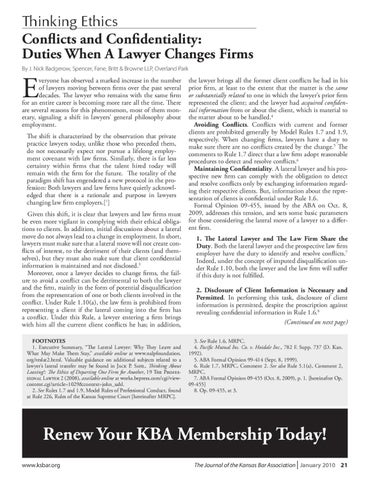Thinking Ethics Conflicts and Confidentiality: Duties When A Lawyer Changes Firms By J. Nick Badgerow, Spencer, Fane, Britt & Browne LLP, Overland Park
E
veryone has observed a marked increase in the number of lawyers moving between firms over the past several decades. The lawyer who remains with the same firm for an entire career is becoming more rare all the time. There are several reasons for this phenomenon, most of them monetary, signaling a shift in lawyers’ general philosophy about employment. The shift is characterized by the observation that private practice lawyers today, unlike those who preceded them, do not necessarily expect nor pursue a lifelong employment covenant with law firms. Similarly, there is far less certainty within firms that the talent hired today will remain with the firm for the future. The totality of the paradigm shift has engendered a new protocol in the profession: Both lawyers and law firms have quietly acknowledged that there is a rationale and purpose in lawyers changing law firm employers.[1] Given this shift, it is clear that lawyers and law firms must be even more vigilant in complying with their ethical obligations to clients. In addition, initial discussions about a lateral move do not always lead to a change in employment. In short, lawyers must make sure that a lateral move will not create conflicts of interest, to the detriment of their clients (and themselves), but they must also make sure that client confidential information is maintained and not disclosed.3 Moreover, once a lawyer decides to change firms, the failure to avoid a conflict can be detrimental to both the lawyer and the firm, mainly in the form of potential disqualification from the representation of one or both clients involved in the conflict. Under Rule 1.10(a), the law firm is prohibited from representing a client if the lateral coming into the firm has a conflict. Under this Rule, a lawyer entering a firm brings with him all the current client conflicts he has; in addition, FOOTNOTES 1. Executive Summary, “The Lateral Lawyer: Why They Leave and What May Make Them Stay,” available online at www.nalpfoundation. org/reslat2.html. Valuable guidance on additional subjects related to a lawyer’s lateral transfer may be found in Jack P. Sahl, Thinking About Leaving?: The Ethics of Departing One Firm for Another, 19 The Professional Lawyer 2 (2008), available online at works.bepress.com/cgi/viewcontent.cgi?article=1029&context=john_sahl. 2. See Rules 1.7 and 1.9, Model Rules of Professional Conduct, found at Rule 226, Rules of the Kansas Supreme Court [hereinafter MRPC].
the lawyer brings all the former client conflicts he had in his prior firm, at least to the extent that the matter is the same or substantially related to one in which the lawyer’s prior firm represented the client; and the lawyer had acquired confidential information from or about the client, which is material to the matter about to be handled.4 Avoiding Conflicts. Conflicts with current and former clients are prohibited generally by Model Rules 1.7 and 1.9, respectively. When changing firms, lawyers have a duty to make sure there are no conflicts created by the change.5 The comments to Rule 1.7 direct that a law firm adopt reasonable procedures to detect and resolve conflicts.6 Maintaining Confidentiality. A lateral lawyer and his prospective new firm can comply with the obligation to detect and resolve conflicts only by exchanging information regarding their respective clients. But, information about the representation of clients is confidential under Rule 1.6. Formal Opinion 09-455, issued by the ABA on Oct. 8, 2009, addresses this tension, and sets some basic parameters for those considering the lateral move of a lawyer to a different firm. 1. The Lateral Lawyer and The Law Firm Share the Duty. Both the lateral lawyer and the prospective law firm employer have the duty to identify and resolve conflicts.7 Indeed, under the concept of imputed disqualification under Rule 1.10, both the lawyer and the law firm will suffer if this duty is not fulfilled. 2. Disclosure of Client Information is Necessary and Permitted. In performing this task, disclosure of client information is permitted, despite the proscription against revealing confidential information in Rule 1.6.8 (Continued on next page) 3. See Rule 1.6, MRPC. 4. Pacific Mutual Ins. Co. v. Hoidale Inc., 782 F. Supp. 737 (D. Kan. 1992). 5. ABA Formal Opinion 99-414 (Sept. 8, 1999). 6. Rule 1.7, MRPC, Comment 2. See also Rule 5.1(a), Comment 2, MRPC. 7. ABA Formal Opinion 09-455 (Oct. 8, 2009), p. 1. [hereinafter Op. 09-455] 8. Op. 09-455, at 3.
Renew Your KBA Membership Today! www.ksbar.org
The Journal of the Kansas Bar Association | January 2010 21
